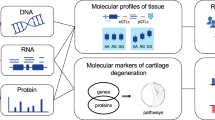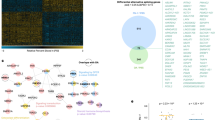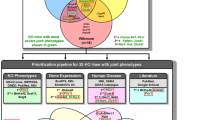Abstract
Primary osteoarthritis (OA) is a common late-onset disease that exhibits complex genetic transmittance. A previous genome-wide linkage scan of OA affected sibling pair families (ascertained by total joint replacement surgery) identified a region of suggestive linkage on chromosome 6, with a maximum multipoint-LOD score (MLS) of 2.9 in 194 families containing sibling pairs concordant for total hip replacement (THR-families). However, up to 50 cM of the chromosome had a multipoint-LOD score >2.0, vvindicating that the susceptibility locus was poorly mapped. We have now genotyped chromosome 6 to a higher density in an expanded cohort of 378 THR-families. We obtained an MLS of 2.8 to an 11.4 cM interval defined by markers D6S452 and 509-8B2, which map between 70.5 to 81.9 cM from the 6p-telomere. Stratification by gender revealed that this linkage was completely accounted for by female THR-families (n=146), with an MLS of 4.0 and with the highest two-point LOD score being 4.6 for marker D6S1573 (75.9 cM). The 11.4 cM interval just encompasses the candidate gene COL9A1 (81.9 cM). We identified and then genotyped twenty common single nucleotide polymorphisms (SNPs) from within COL9A1 in the 146 probands from our female THR-families and in 215 age-matched female controls. No SNP allele, genotype or haplotype demonstrated association to disease. Overall, we have narrowed the chromosome 6 OA susceptibility locus to a point at which linkage disequilibrium/association analysis is feasible, we have demonstrated that this locus is female specific, and found no evidence that COL9A1 encodes for the susceptibility.
Similar content being viewed by others
Log in or create a free account to read this content
Gain free access to this article, as well as selected content from this journal and more on nature.com
or
References
Loughlin J . Genetic epidemiology of primary osteoarthritis Curr Opin Rheumatol 2001 13: 111–116
Chapman K, Mustafa Z, Irven CM et al. Osteoarthritis-susceptibility locus on chromosome 11q, detected by linkage Am J Hum Genet 1999 65: 167–174
Loughlin J, Mustafa Z, Irven C et al. Stratification analysis of an osteoarthritis genome screen – suggestive linkage to chromosomes 4, 6 and 16 Am J Hum Genet 1999 65: 1795–1798
Loughlin J, Mustafa Z, Smith A et al. Linkage analysis of chromosome 2q in osteoarthritis Rheumatol 2000 39: 377–381
Ayad S, Boot-Handford RP, Humphries MJ, Kadler KE, Shuttleworth CA . The extracellular matrix facts book 2nd edn London: Academic Press 1998 pp 84–89
Warman ML, Tiller GE, Polumbo PA et al. Physical and linkage mapping of the human and murine genes for the α1 chain of type IX collagen (COL9A1) Genomics 1993 17: 694–698
Pihlajamaa T, Vuoristo MM, Annunen S, Perälä M, Prockop DJ, Ala-Kokko L . Human COL9A1 and COL9A2 genes. Two genes of 90 and 15 kb code for similar polypeptides of the same collagen molecule Matrix Biol 1998 17: 237–241
Horton WE, Wang L, Bradham D, Precht P, Balakir R . The control of expression of type II collagen: relevance to cartilage disease DNA Cell Biol 1992 11: 193–198
Clayton D . A generalization of the transmission/disequilibrium test for uncertain haplotype transmission Am J Hum Genet 1999 65: 1170–1177
Abecasis GR, Cookson WOC . GOLD – Graphical overview of linkage disequilibrium Bioinformatics 2000 16: 182–183
Reich DE, Cargill M, Bolk S et al. Linkage disequilibrium in the human genome Nature 2001 411: 199–204
Daly MJ, Rioux JD, Schaffner SF, Hudson TJ, Lander ES . High-resolution haplotype structure in the human genome Nature Genet 2001 29: 229–232
Jeffreys AJ, Kauppi L, Neumann R . Intensely punctate meiotic recombination in the class II region of the major histocompatibility complex Nature Genet 2001 29: 217–222
Czarny-Ratajczak M, Lohiniva J, Rogala P et al. A mutation in COL9A1 causes multiple epiphyseal dysplasia: further evidence for locus heterogeneity Am J Hum Genet 2001 69: 969–980
Mustafa Z, Chapman K, Irven CM et al. Linkage analysis of candidate genes as susceptibility loci for osteoarthritis – suggestive linkage of COL9A1 to female hip osteoarthritis Rheumatol 2000 39: 299–306
Gerecke DR, Olson PF, Koch M et al. Complete primary structure of two splice variants of collagen XII and assignment of α1(XII) collagen (COL12A1), α1(IX) collagen (COL9A1), and α1(XIX) collagen (COL19A1) to human chromosome 6q12-q13 Genomics 1997 41: 236–242
Reddi AH . Interplay between bone morphogenetic proteins and cognate binding proteins in bone and cartilage development: noggin, chordin and DAN Arthritis Res 2001 3: 1–5
Acknowledgements
This work was funded by The Arthritis Research Campaign, The Wellcome Trust and the Nuffield Foundation (to J Loughlin), and by the Arthritis Foundation, the Academy of Finland, Louisiana Gene Therapy Research Consortium (New Orleans, LA, USA) and HCA-The Health Care Company (Nashville, TN, USA) (to L Ala-Kokko). J Loughlin is an Arthritis Research Campaign Fellow. We thank Professor Andrew Carr, Dr Jai Chitnavis and Ms Kim Clipsham who organised the collection of the patient and family samples used in this study. That collection was partly funded by The Wishbone Trust.
Author information
Authors and Affiliations
Corresponding author
Rights and permissions
About this article
Cite this article
Loughlin, J., Mustafa, Z., Dowling, B. et al. Finer linkage mapping of a primary hip osteoarthritis susceptibility locus on chromosome 6. Eur J Hum Genet 10, 562–568 (2002). https://doi.org/10.1038/sj.ejhg.5200848
Received:
Revised:
Accepted:
Published:
Issue date:
DOI: https://doi.org/10.1038/sj.ejhg.5200848
Keywords
This article is cited by
-
Association study of candidate genes for susceptibility to Kashin-Beck disease in a Tibetan population
BMC Medical Genetics (2017)
-
The minor collagens in articular cartilage
Protein & Cell (2017)
-
IL1B -511(G>A) and IL1RN (VNTR) allelic polymorphisms and susceptibility to knee osteoarthritis in Croatian population
Rheumatology International (2012)
-
Mapping quantitative trait loci for canine hip dysplasia in German Shepherd dogs
Mammalian Genome (2007)
-
Mutations in the known genes are not the major cause of MED; distinctive phenotypic entities among patients with no identified mutations
European Journal of Human Genetics (2005)



